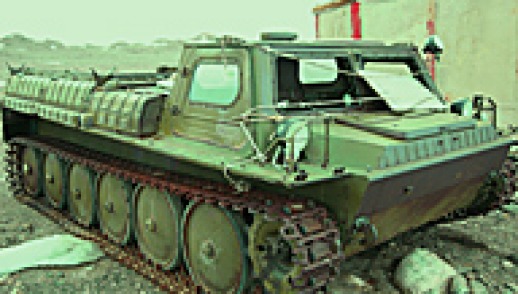MOMENTS in time are perfectly preserved in the freezer of Antarctica. By a summer lake in a valley about 400 kilometres west of Australia's Casey base, the ColdWar still endures, overlaid by the thawing of glasnost.
After about eight kilometres trekking out of Australia's field station at BungerHills, clambering over the trail of rock rubble left by a long-departed glacier and drifts of snow dumped in the most recent blizzard, tank tracks appear pressed into the shoreline.
Follow them over the hills, the path marked by the litter of wire and plywood and tin cans, and you find a huddle of weather-worn buildings, timbers running yellow and brown with the stains of time, and a collection of rusting tanks, fuel drums and gas cylinders.

The Russians were here. And their machinery still lies on the ice. Even in the lake, pilots flying overhead sometimes glimpse the shadow of an old Antonov lying in the depths.
The white field above is strewn with fallen masts and tangled cables, the clunky hardware and gadgetry of longdefunct communications technology. For listening, and talking, to whom?
In 1956, the Soviets built the base and called it Oasis— although the silver plaque mounted in one cabin puts the date at 1955.
A few years later, it was handed over to Poland and renamed Dobrowolski, and still has rare visits by hardy souls sent to fly the flag and maybe do some science.
The most recent pair landed briefly just a couple of summers ago, according to the graffiti they left.
To walk into the mess building is a little like happening upon the wreck of theMary Celeste. The table is littered with cooking pots and plates, rotted fruit, half a loaf of bullet-proof bread and a few slices of pink sausage.
It's as if the helicopter has just flown in to retrieve the diners and they have simply got up, put on their coats and gone. There's a wine glass full of cigarette butts and there are empty vodka bottles tossed in the cupboards.
A picture board stuck to the wall from a 1987 expedition is crowded with black-and-white snaps of whiskery men pouring shots and engaged in passionate dinner table discourse in this very room.
Alongside are pictures of the same men out in the field— diving into the lake with their instruments and waving in huge choppers with the tanks dangled beneath them.
In the corner there's a stack of 78 records with 'CCCP' emblazoned across red labels, and a gramophone that can be wound into action. Soon the voice of a Russian soprano begins to warble and crackle and fill the air, which is rank with remnant smells of food and fuel.
It's reassuring to remember, rummaging in the cupboards, that there can be no rats, no spiders. Just ghosts. Behind the gramophone a Soviet flag hangs over the doorway to one of the dormitory rooms, where thin horsehair mattresses and old blankets don't promise too much comfort in the biting cold.
Speaking of cold comfort, there are, of course, the inevitable soft-porn posters of women, much cherished in an unreconstructed era of boysown adventure.
In other bunkers, other rooms, are 1950s radios set up to send morse code messages, piles of smashed vials of medicines, newspapers in Polish, Russian and English dating over 30 years, and musty volumes of technical and scientific reading.
Over one bed, scrawled in red, Dale Anderson of NASA Research Station California declares he is here as part of a "joint US/Russia BungerHills Expedition 1991-92—'Onwards ToMars!' ".
A new era, new dreams, but enduring only in this forgotten place.